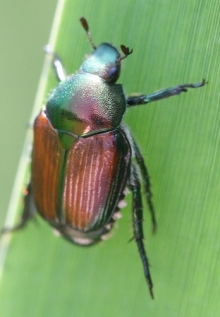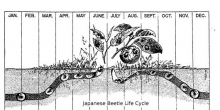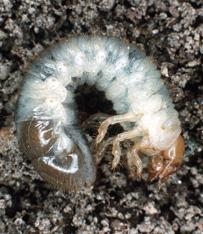Japanese Beetles

An adult Japanese Beetle

The life cycle of a Japanese Beetle

Mature grubs are difficult to control in the spring.
Tuesday, March 15 | Gardening Info
Native to Japan, this beetle is thought to have been introduced to the United States as early as 1916. With few natural predators, the beetle has become a major pest for farmers and gardeners alike.
Life Cycle:
In most parts of the US, the Japanese Beetle’s life cycle lasts one year. Eggs are laid in early July and the young larvae spend the rest of the summer and fall under ground in grassy areas eating roots until they go dormant for the winter months. The larvae remain largely dormant through the spring until the soil warms enough for them to pupate and eventually emerge in late June to begin breeding (and ravaging gardens).
Local Control:
Japanese Beetles are easy to kill. Readily available carbaryl, acephate or even pyrethrins will yield good knockdown against the beetles. Unfortunately, due to the beetles’ transient nature, applications of contact killers must be repeated regularly.
Traps:
Most traps rely on pheromone or floral lures to attract beetles to an inescapable collection bag. While the traps are very effective at attracting beetles, it is debated whether they actually attract more than they capture. Either way, many gardeners get a great deal of satisfaction collecting bags of dead enemy beetles.
Grub Control:
The best time to control Japanese Beetles is the year before they hatch. Application of a granular grub killer to lawns in late July when the young grubs are actively feeding near the surface yields good results. Application in the spring is less effective as the grubs are deeper in the soil and are not actively feeding. Grub control is especially effective when large, contiguous areas of lawns are treated, so coordinate with your neighbors!
Milky Spore:
Milky spore is a naturally occurring soil bacterium that is lethal to many grubs, including the Japanese beetle. A lawn with a healthy population of milky spore bacteria is almost immune to grubs. The bacterium is available in a powdered form for lawn application. Once established, milky spore persists in the soil for upwards of 20 years. Unfortunately, 3-5 years of annual treatments are required to establish the bacteria and each application is fairly expensive compared to a traditional chemical grubicide.




